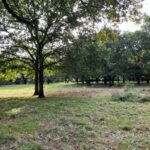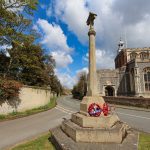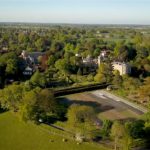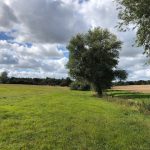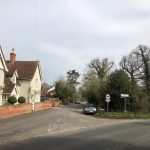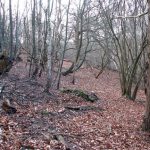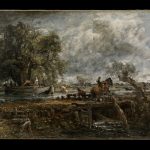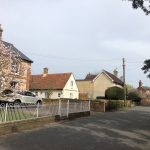East Bergholt has a long and rich history dating back to before the Middle Ages. The village is clustered around an extensive heath that was common land supporting the local population until it was divided up amongst the existing landowners in the period of the legendary 18/19 Century Enclosures Acts. The famine that this caused led to the depopulation of the countryside with landless workers forced to seek employment in emerging industrial centres like Ipswich. The Box Iron remains an undeveloped and largely unchanged area of public heathland giving us a fascinating rearview mirror sense of what the village must have been like pre-Enclosures.
The Box Iron gives us a valuable insight into those pre-enclosures days. Although privately owned, it remains an area of undeveloped heath land, populated with wild meadows and huge oak trees.
As modern East Bergholt converts its open fields into rows of new houses, the Box Iron remains one of the last few open public areas in the village. areas. Sadly, East Bergholt's famed bucolic past of rural idyl, as portrayed in John Constable's wonderful landscapes, has now changed - East Bergholt having been reported as one of Babergh District's villages most lacking in available public open spaces.
The area at the centre of the village, defined by its significant historic buildings and the early origins.
East Bergholt Village Heart encompasses an area of land bordering Gaston Street, The Street and Rectory Hill, between the two main settled parts of the village. This is a part of a designated Conservation Area and is wholly within the Dedham Vale AONB.
The Donkey Track is a long-established footpath which runs northwards from Gandish Road across what was originally the village "heath" or "common".
To the south-west of the track, the undulating land is divided by the Riber stream which continues across Rectory Hill and eventually down to the Stour.
The western boundary is created by the rear of The Old Rectory and properties which face Rectory Hill, The Street, and Gaston Street.
The north-eastern side of the track is distinguished by a 20-year-old woodland at the southern end leading to cultivated fields divided by hedges leading up to Heath Road/Mill Road, the main vehicular route around East Bergholt. The rear of the 1970's Richardson Road estate and the Medical Surgery complex abut the land to the north.
This area is a well-defined triangle formed by Quintons Road, Woodgates and Heath Road containing historic open space and many historic buildings.
Most of the land on the North side of Quintons Road also falls into this category
In addition, the land from the end of Gaston Street, along Heath Road from the Carriers pub to the Hare & Hounds pub, is worth also of conservation area consideration, together with the allotment land at the rear.
This section runs from the village centre at the Gaston Street junction, from The Gables* along the western side of Hadleigh Road to the junction with Hughes Road (* The Gables is a listed building which sits in the current Conservation Area).
While the eastern side of the road is not for conservation area consideration, (mainly lined with set-back 20thC and 21stC houses and the school playing field), it does contribute to the attractive natural tree cover that characterizes the road.
Together with the western side, the mature trees create a pleasing “tunnel” effect over the road at all seasons. The tree-lined frontages for historic buildings such as Gatton House and Ackworth House, which are spaced out along the road, with driveway entrances such as the one for the Gattinets business units. Generally, these historic buildings are only partly visible from the road where the vegetation predominates, with no pavement on this side.
At the top Hadleigh Road intersects with Hughes Road and Elm Road, before it continues northwards. Here there is a large open meadow in front of the historic Allens Farmstead, and features the gated drive to the Grade 2* -listed “The Lodge”, which is not really visible from the road.
Flatford itself is a small cluster of buildings on the banks of the River Stour to the south of East Bergholt. It includes the famous Flatford Mill, together with other historic structures such as the lock, the bridge, the Granary, Valley Farmhouse and Willy Lott’s Cottage.
It is served by Flatford Lane on the north side of the river, which runs in a loop from the crossroads at Gandish Road/White Horse Road junction downhill towards the National Trust CarPark, and then uphill to East Bergholt Church.
The area is within the Dedham Vale AONB; with cross-country pedestrian and boat access to Dedham itself. The land for consideration for Conservation Area status also comprises the fields and woods either side of Flatford Lane, and the mill-related properties on the riverside.
Gaston Street has been an important thoroughfare in East Bergholt for centuries, linking the village centre and The Street in the south, with the area once known as Gaston End in the north, where it now adjoins the B1070. Today it lies on a bus route into the village and is a main access route. The street widens as it approaches the village centre.
Gaston Street is a primarily residential street with a wide variety of house types, sizes and styles. The two exceptions are Richardson’s farm which remains a working farm, with its listed farmhouse situated towards the northern end, and the single storey Lambe School, founded in 1594 and now used as a village hall, located closer to the village centre. The latter sits opposite some large houses built in classical style in the late 20th century.
Gaston Street remained largely undeveloped until Victorian times. In 1851 there were only 16 houses on Gaston Street with Tufnells located at one end and The Gothics at the other. Since then any gaps have been filled to provide an eclectic and interesting streetscape with 10 listed buildings scattered on both sides of the street intermixed with more modern development with a wide range of building styles. The street scene is enhanced by the number and type of large mature trees, many with TPOs.

